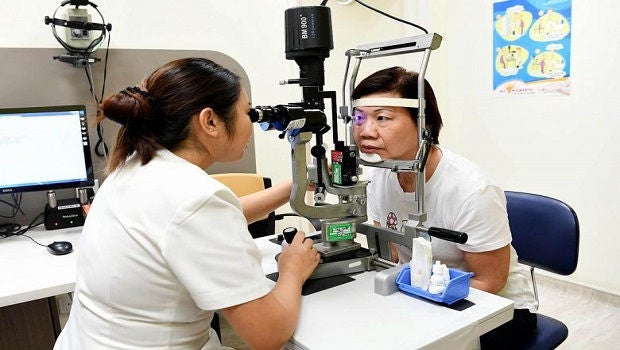
A Singapore National Eye Centre spokesman said the "new models of care" include getting nurses and optometrists to take on some of the patient care. PHOTO: ST FILE
The Singapore National Eye Centre (SNEC) has cut its fees for 20 procedures by between 15 and 32 per cent, fulfilling a promise made in January.
The cut in fees will affect about 14,500 procedures done at the eye centre each year, its spokesman told The Straits Times. The move could cut each bill by up to several hundred dollars.
The fee cut was promised in January after it was revealed in The Straits Times that high fees were resulting in subsidised patients not getting full coverage from MediShield Life.
When the national insurance scheme was launched, it aimed to cover big bills for nine out of 10 fully subsidised patients, beyond the initial deductible amount they have to pay and the co-payment.
However, it was recently revealed that coverage had dropped to eight in 10 fully subsidised bills, due in large part to public hospitals and institutions raising fees to levels much higher than those covered by insurance.
One SNEC patient, Mr Seow Ban Yam, 82, received only $4.50 from MediShield Life for a fully subsidised bill of $4,477. Based on a table of charges published by the Ministry of Health (MOH), MediShield Life can cover up to $2,800 of his subsidised surgical fee. But the SNEC charged $4,272.
When the problem was raised, the MOH said SNEC's fees were higher than those at other public hospitals offering similar services, and that it would work with the centre to review its fees - leading to the current cut.
An SNEC spokesman said the drop in prices was made possible by "reviews of care models, improvements to operational efficiency and regular adjustments in MOH funding support in accordance with changes in cost of care provision".
The spokesman said the "new models of care" include getting nurses and optometrists to take on some of the patient care.
One of the biggest cuts in terms of percentage drop, but not in terms of dollar value, is for intravitreal injection - excluding the cost of the medication - that is used to treat age-related macular degeneration. This has gone down from $133 to $96, or by 28 per cent.
So the cost of giving the intravitreal injection has gone down largely because it can be given by nurses instead of by doctors.
Another example that has led to lower prices is getting "specially trained" optometrists - instead of ophthalmologists - to "examine and monitor common eye conditions in follow-up patients". The spokesman explained: "This allows patients to be supported by a wider healthcare team according to their needs."
Patients who need the same surgery as Mr Seow - called dacryocystorhinostomy (duct drainage surgery or DCR) - as well as procedures such as glaucoma surgery with implant and retinal detachment surgery "will see subsidised bill sizes lowered by an average of 25 per cent", the spokesman said.
He added that for DCR, the average subsidised bill size for one eye has been "revised from $2,497 to $1,887".
The MediShield Life claim limit for subsidised patients for this procedure is $1,400 for one eye.
The MOH said previously that for this procedure, "over nine in 10 of the subsidised charges for DCR in the other institutions are within MediShield Life claim limits".
SNEC has offered Mr Seow a goodwill payment of $1,300 - or about the amount MediShield Life would have covered if the entire bill had been within the limits set.
SOURCE: THE STRAITS TIMES SINGAPORE PRESS HOLDINGS LIMITED. REPRODUCED WITH PERMISSION.
Contributed by














 Get it on Google Play
Get it on Google Play